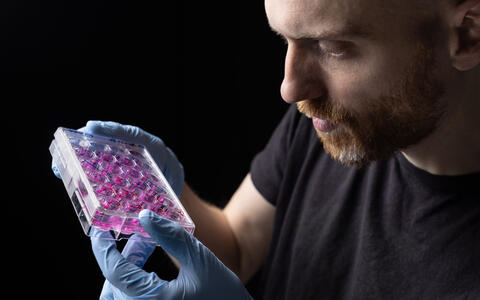The juggler of numbers
Dr. Jakob Metzger never gets bored of watching frog eggs develop. The time-lapse videos showcase a flawless program – a biological code that is precisely executed, producing viable tadpoles within days. Human embryos develop similarly in the womb: Right on cue, by the third week, they begin forming a nervous system and a brain. “The process runs on an exact schedule, governed by rules encoded within cells,” says Metzger. “This incredible complexity of embryonic development is our model. We're trying to recreate it, but it hasn’t been easy. Nature had a head start billions of years ago.”
Metzger is both a physicist and developmental biologist. In his lab, he grows brain organoids – three-dimensional tissues cultivated in Petri dishes that consist of various brain cell types. To some extent, they can mimic specific human brain regions and their function. Metzger aims to understand how healthy brains develop and to identify how the process goes awry, leading to neurodegenerative diseases with all their consequences. Understanding the mechanisms, he hopes, will lead to novel new treatments.
At the Max Delbrück Center, Metzger leads the Quantitative Stem Cell Biology lab. The “stem cell biology” part of his research comes from the fact that the organoids are grown from patient-derived cells that have been turned into a more primitive stem cell. The “quantitative” aspect comes from his approach to developmental biology through the eyes of a physicist. “I see biology as a complex system that can be can be captured in numbers and to which I can apply mathematical equations,” he says.
Using the latest imaging and molecular “omics” methods, he generates large amounts of data from his organoids, and mines it using machine learning tools. He programs the neural networks required for this himself. Jakob Metzger is a juggler – he juggles with disciplines and technologies, but above all with numbers – and incidentally with balls, a hobby since his youth.
A career bridging physics and biology
As a doctoral student, Metzger was focused on numbers. At the Max Planck Institute for Dynamics and Self-Organization in Göttingen, he calculated the propagation of waves through random media – a theoretical basis for predicting tsunamis. After a postdoc, his interest in physics gradually waned. But not his interest in numbers.
A workshop on morphogenesis in Santa Barbara, California, awakened his enthusiasm for hands-on experimentation. He worked in a laboratory studying zebrafish. At the time, developmental biology was increasingly relying on large amounts of data. So, he decided to move to New York City to work with Professor Eric Siggia at Rockefeller University, a very successful physicist working on developmental biology. “In biology, there are a lot of random influences, i.e. stochastics, and a lot of non-linear processes,” says Metzger. “For me, the exciting thing is how biological systems can cope with all this chaos and still be so robust.”
Switching to biology was a leap into the unknown, requiring countless hours to master laboratory techniques. For five years, he developed “neuruloids” – mini-brain organoids that mimic the earliest stages of brain development. He and his colleagues used them to screen almost 3,000 potential drugs to treat Huntington's disease – a genetic disease that affects the brain and nervous system – and programmed machine learning methods to evaluate the data. In 2019, as co-first author, he described the potential of brain organoids for research on Huntington's disease in a paper in “Nature Biotechnology.”
Smaller organoids, but scalable
In biology, there are a lot of random influences, i.e. stochastics, and a lot of non-linear processes. For me, the exciting thing is how biological systems can cope with all this chaos and still be so robust.
In 2020, the then 37-year-old joined the Berlin Institute for Medical Systems Biology at the Max Delbrück Center (MDC-BIMSB), because he thought it would be a good opportunity to continue juggling disciplines, methods and numbers. With eleven colleagues, whose expertise range from biology, physics and computer science, he further developed miniature brain organoids. They are smaller than standard brain organoids used in experiments – they measure only about 0.5 millimeters instead of 1 to 3 millimeters – and contain fewer brain cell types. However, because they can be mass-produced and are very similar to each other, they minimize the variation in the data collected from experiments performed on them. Consequently, they provide particularly high-quality data with high statistical power. “We can make more confident conclusions, for example about which genes are especially active in a disease,” says Metzger.
One of the brain disorders that Metzger aims to investigate with his brain organoid models is NEDAMSS – a very rare and incurable neurological developmental disorder. The disease is caused by a mutation in the IRF2BPL gene. Affected children gradually lose their abilities. The disease was only discovered a few years ago. “It is still unclear what the healthy variant of this gene does in the brain and what exactly goes wrong when it is mutated,” says Metzger.
To understand in what cell types the defective IRF2BPL gene is active, its function, and to identify other genes with which it interacts, Metzger first uses brain organoids of standard size, which contain a variety of cell types. “Once we know what cells the disease affects and what the phenotype looks like, we can create the appropriate mini-organoids,” he explains. The mini organoids enable him to zoom-in – narrow the focus, and increase the level of detail.
A signature for each disease
The organoids are typically derived from the blood or skin cells of patients. These cells are first reprogrammed into induced pluripotent stem (IPS) cells, which have the ability to develop into brain cells. In a nutrient solution, they continue to divide, differentiate, and grow into spherical organoids within one to four months. The solution contains signaling molecules – the very same that the cells receive from surrounding tissue during embryonic development – which direct the cells self-organize. “The organoids are far from being a real brain, but it’s a functional system with interconnected neurons – and it's very useful for modeling diseases,” says Metzger.
But before growing organoids to study diseases such as NEDAMSS, Metzger's team first genetically engineers the IPS cells. Using CRISPR/Cas gene-editing tools, they can either remove a disease-causing mutation from the cells, or introduce it. They grow organoids from these genetically altered cells and then expose the diseased organoids to different drugs. “We can see from the data whether or how closely the signature from diseased organoids resembles the healthy phenotype again,” says Metzger.
The signature Metzger is referring to is a measure of activity of genes, proteins or other biomolecules. To make proteins signatures visible, for example, Metzger's team marks disease-causing proteins with fluorescent tags. In this way, the researchers can observe under a microscope, how they accumulate. Using single-cell RNA sequencing, the team can also quantify RNA molecules of interest in thousands of cells simultaneously to determine the activity of specific genes. Proteomic techniques, in turn, allow all proteins in a cell to be measured, enabling researchers to distinguish patterns of healthy protein levels compared to diseased ones. All of this data gradually forms a comprehensive fingerprint of the disease.
“Machine learning is ideally suited for analyzing such vast amounts of data,” says Metzger. “You can train neural networks to compare healthy organoids with diseased ones based on the available data and uncover complex relationships that humans would not readily recognize.” For example, whether one protein is more likely to appear alongside another when a third is present. “Ultimately, artificial intelligence can use all the data to predict which drugs hold promise.”
The secret of brain development
In addition to NEDAMSS and Huntington's disease, Metzger's team is also studying autism spectrum disorders and Alzheimer’s disease. For example, his lab is studying how the APOE4 gene increases the risk of developing Alzheimer's disease. Since mini-organoids can be produced in large quantities, they enable simultaneous testing of many drug candidates, either individually or in combination, enabling researchers to identify optimal combinations and dosages to tailor treatments to individual patients.
While Metzger has been focused on understanding neurological diseases, he has not abandoned basic research. He also uses organoids to understand how the human brain develops. Human brains have evolved complex developmental cues that work together like a symphony from birth through adulthood. Metzger hopes that his organoids will help reveal some of nature’s secrets, he says, such as the cues precursor cells use to stop forming neurons and instead to become astrocytes – cells that provide support to neurons. “And how do brain cells even know when to stop building brain mass during human development?”
Text: Mirco Lomoth









